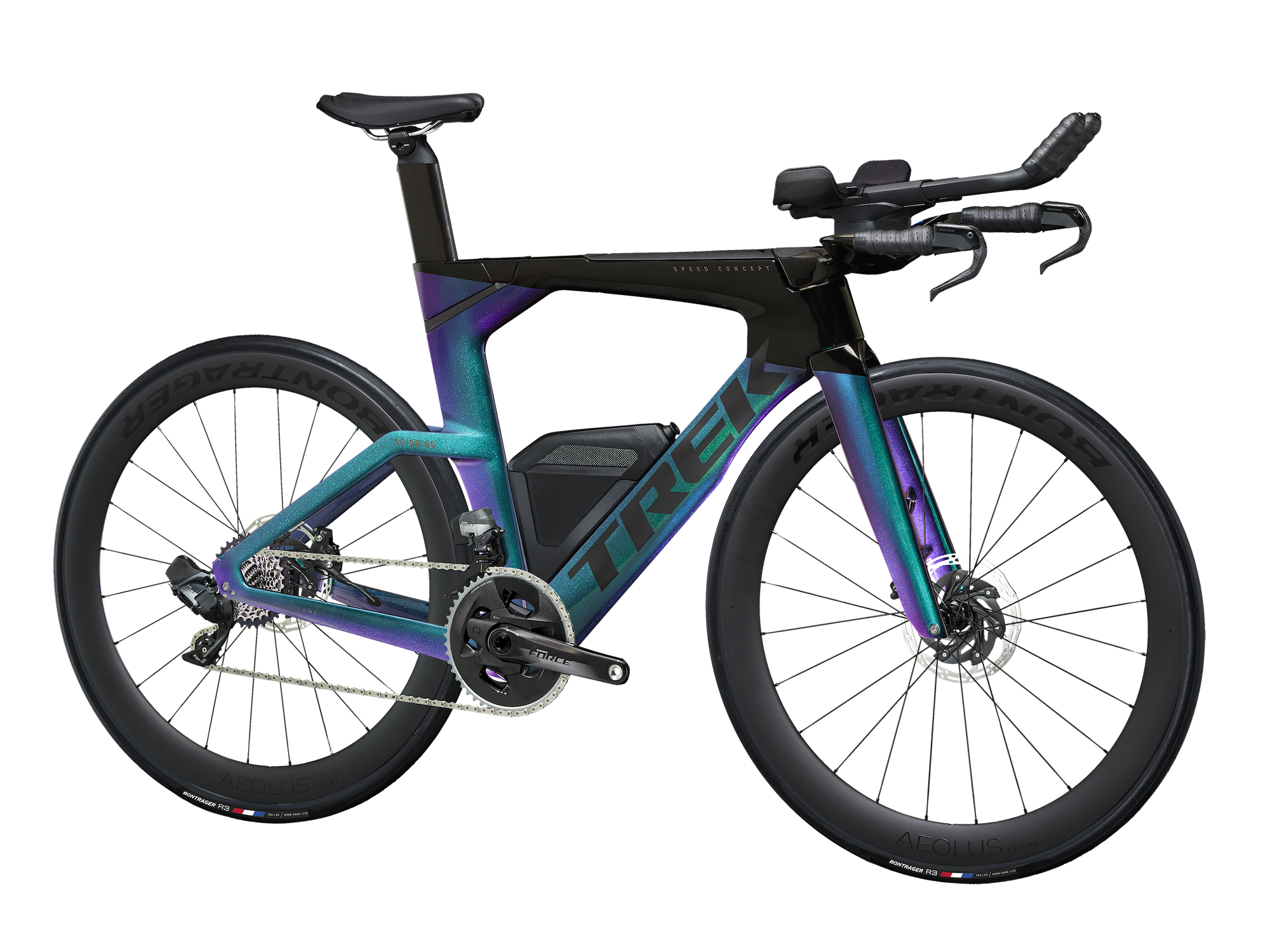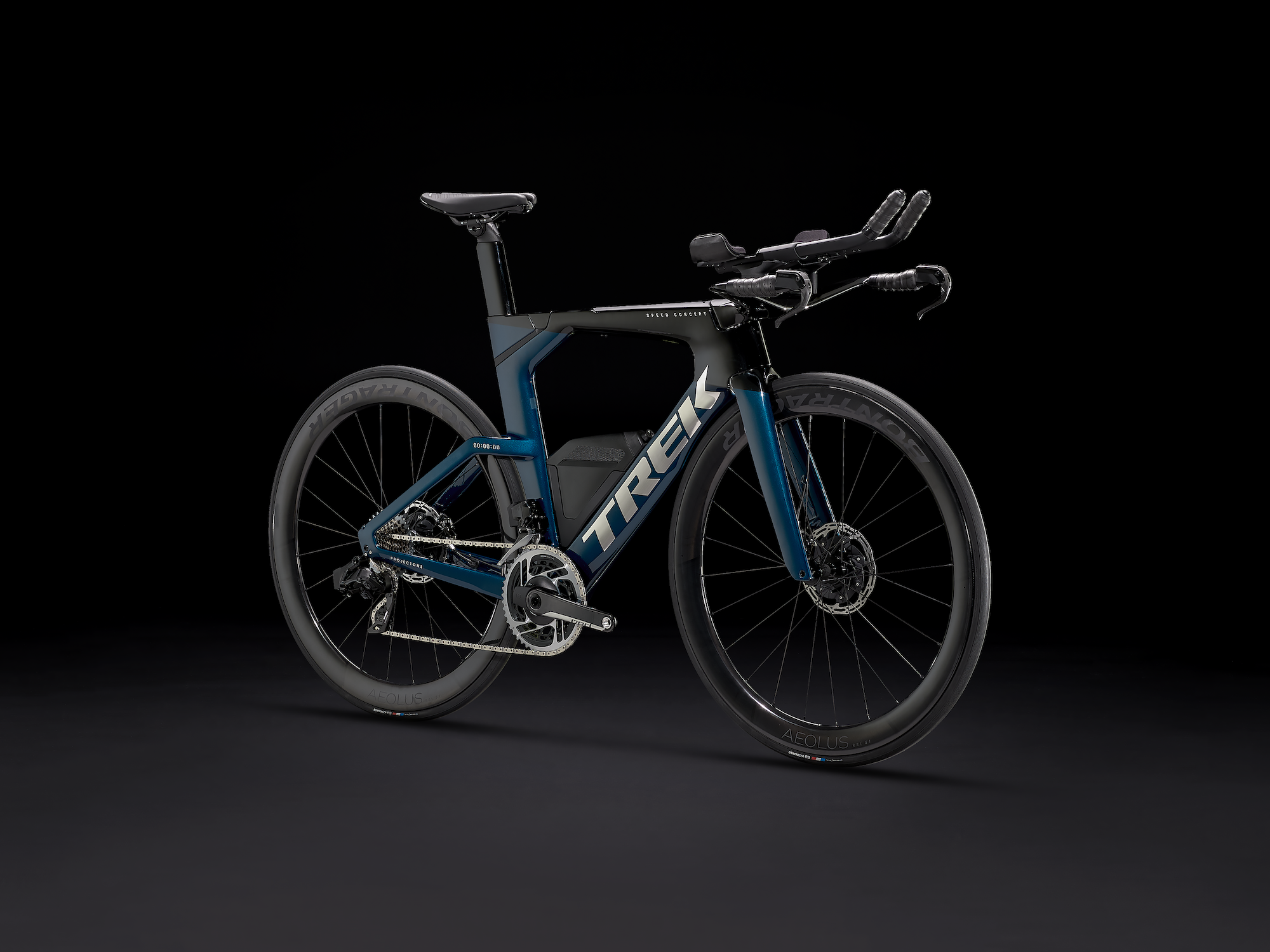Trek launches all-new Speed Concept triathlon bike
Trek's all-new Speed Concept is here and it's said to save you six minutes over a full Ironman

Trek has today unveiled its all-new Speed Concept triathlon bike after seven years of development, promising a saving of six minutes over the bike leg on the Kona Ironman course.
In addition to those claimed improvements in speed, the American brand appears to be marketing its new bike on four key pillars. Aside from speed, Trek is keen to shout about the Speed Concept’s ability as a ‘complete triathlon solution’, its improvement in comfort and its adjustability.
Saving six minutes
Although Trek says the previous Speed Concept is still one of the fastest bikes in the world, the brand says the new iteration is an impressive 16 watts faster (at 45kph). That’s the equivalent of a six-minute saving over a typical Ironman course and is based on the average across different yaw angles (essentially meaning the direction of the wind).
The brand says this is the ‘fastest bike we’ve ever tested, of any brand’, and that these improvements are a combination of aerodynamic tweaks (four-minute saving) and reduced rolling resistance (two-minute saving).
The latter is made possible due to the Speed Concept’s switch from rim brakes to disc brakes, which opened up the opportunity to use Bontrager’s RSL wheelset and enhanced braking power. While Trek’s engineers admit the disc rotors generate drag, they say the switch has allowed them more freedom with the frame design and the ability to tweak rim shapes.
While the six-minute time saving is quoted at a lofty 45kph, the brand’s aerodynamicist John Davis says that you’ll actually save more time at slower speeds. “If you decrease the power down to 210 watts and run that simulation again, the time savings actually go up to about seven minutes.
“The slower you go, the more absolute time savings you get over the course, because you have more time for that aerodynamic advantage to build up.”
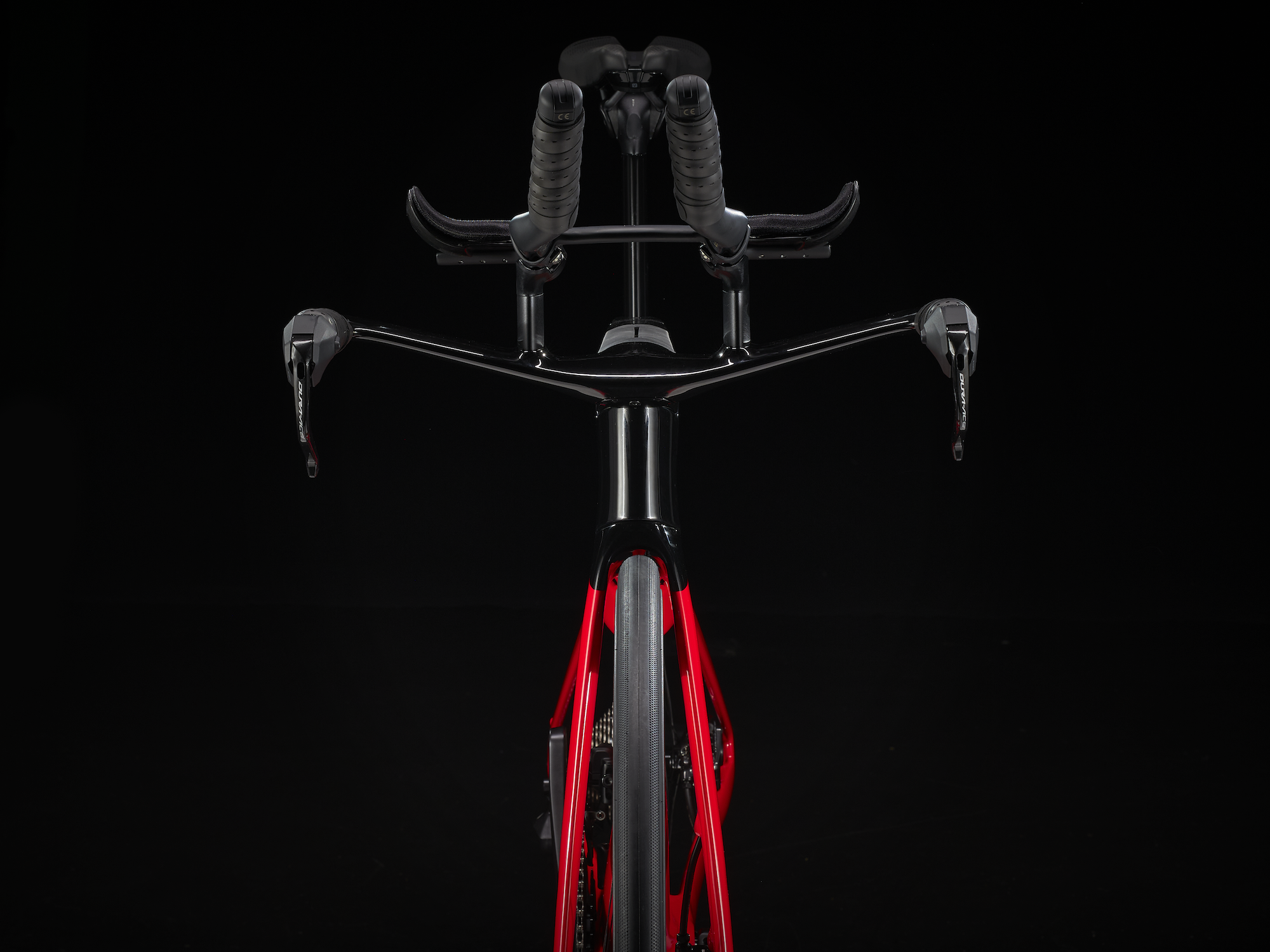
With regard to the aerodynamic improvements, Davis says: “Every little part of the bike has been touched. We saw really marginal gains on each of these [elements] in CFD (computational fluid dynamics), but then you go into the wind tunnel and you’re able to see these gains in the wind tunnel too.
“Then you can combine them all for a final product that really has a big improvement.”
Examples of these tweaks include shaping and streamlining the cockpit. In doing so, the team played with the rear shaping of the pad holder to get the flow of air to attach behind the elbows, which they say helped a lot with airflow around the legs.
They also changed the mono extension on the handlebars to a dual extension. This was in order to manipulate dirty air onto the legs instead of between them.
A ‘complete triathlon solution’
This new machine has been built to be the ‘complete triathlon solution’, with integrated storage and hydration components that Trek believes can hold a full-distance triathlon’s worth of supplies without resulting in an aero cost.
In fact, the team says that the bike is actually one minute quicker with the storage solutions than without them. But what exactly are these storage solutions? Well, they include:
A between-the-arms bottle

Between-the-arms (BTA) bottles have become popular due to the fact that you don’t have to move off of the aerobars to take on fluids, but they can also play a big role in aerodynamics.
Trek says that’s the case here, with the brand’s BTA bottle said to smooth turbulent air. It can hold up to 700ml and, handily, can be refuelled with another bidon bottle (or the downtube bottle) via an integrated silicone port. In theory, Trek says this can be done on the fly, saving you vital time.
To drink from the bottle, you simply unclip the straw and drink, before clipping it out of the way again. It’s also said to be possible to add an extra cage and bottle to the unit for additional storage.
Unlike the three items below, the BTA bottle does not come with the bike and is sold separately.
An integrated bento box
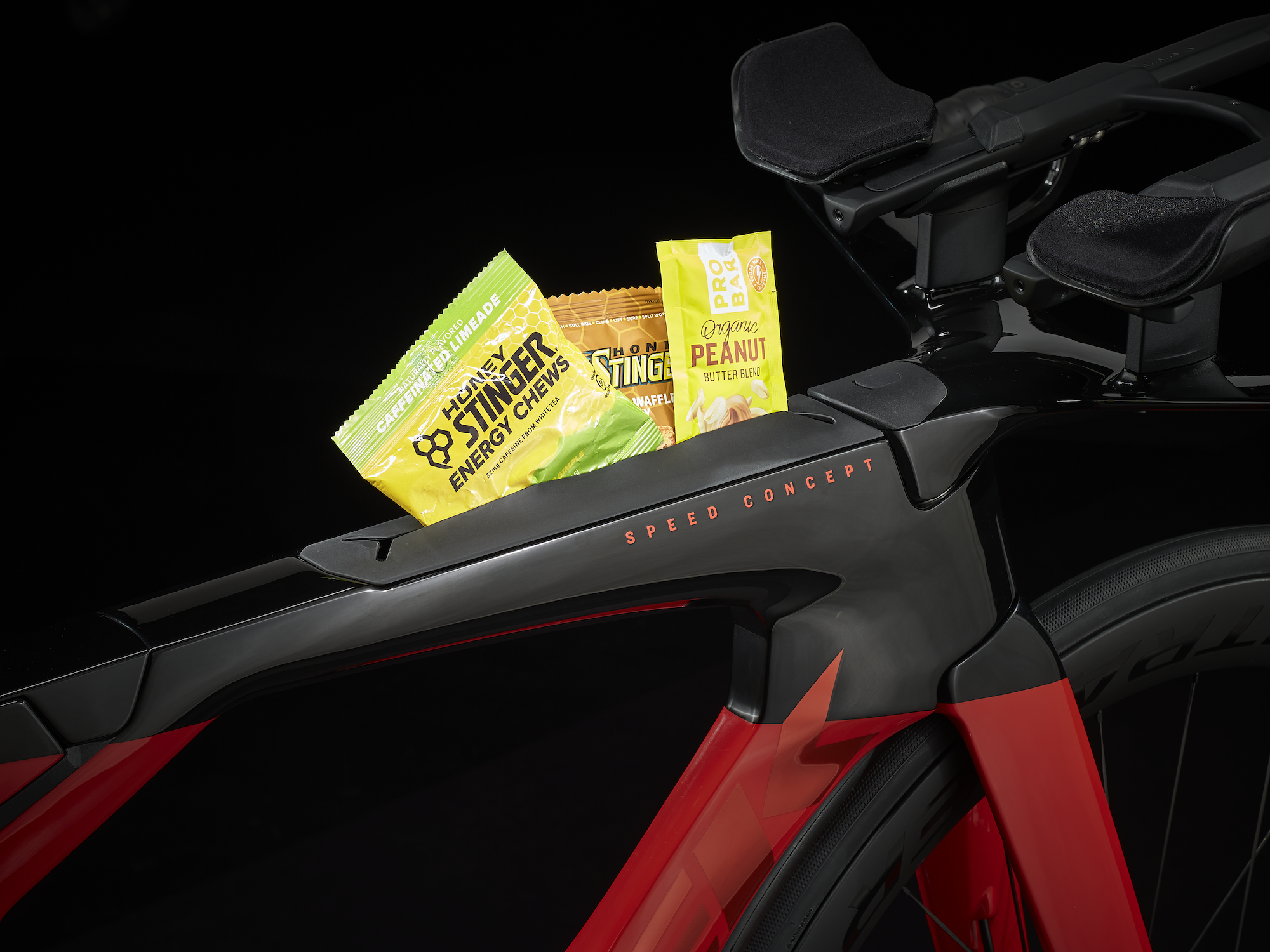
On the top tube you’ll find an integrated bento box for storing nutrition. Trek says the space, which has two removable dividers, is large enough to hold eight standard gels.
If you’re prone to making a mess when using gels, you’ll also be glad to hear that this compartment is removable and dishwasher safe.
A downtube bottle
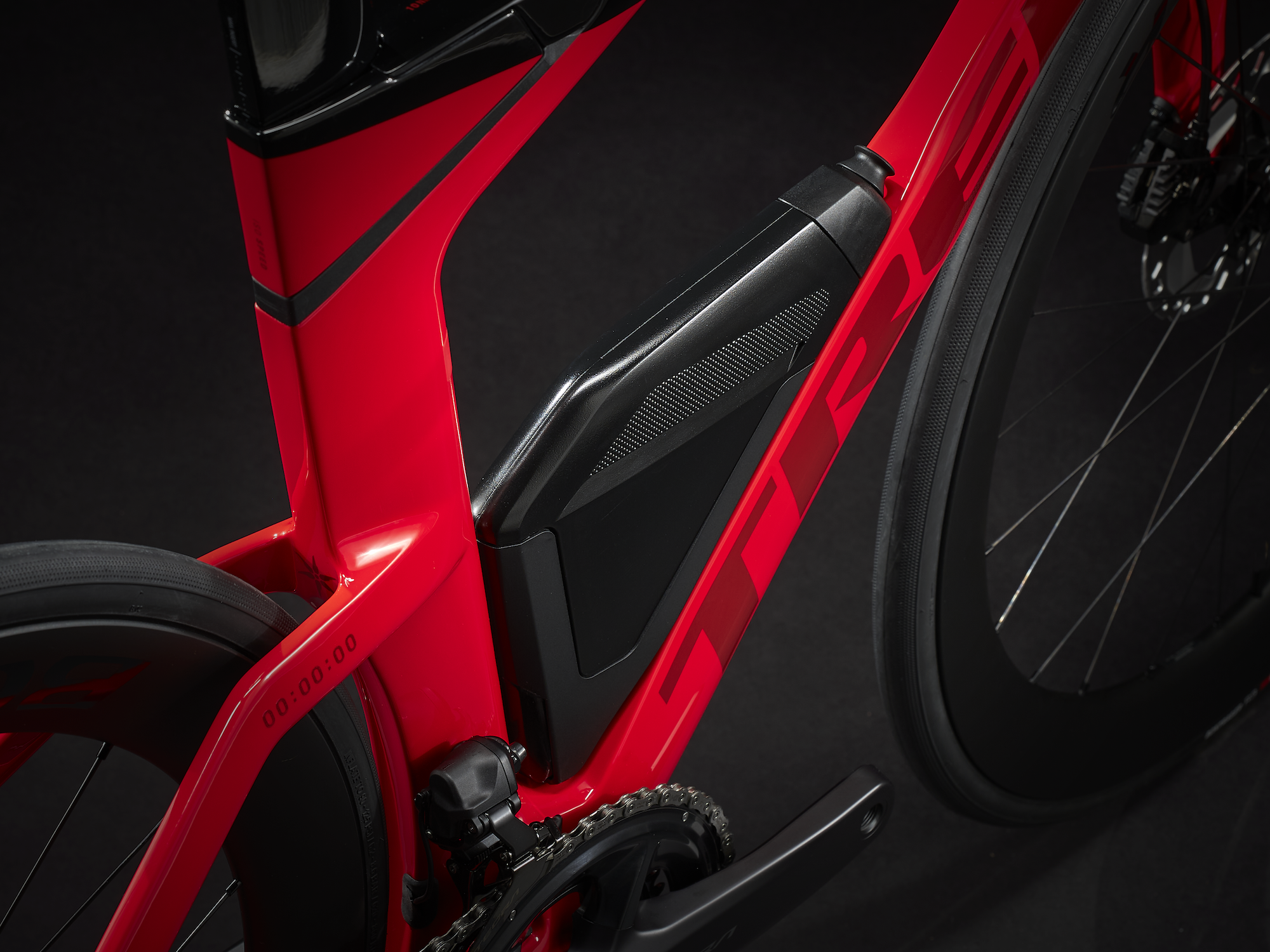
In addition to the aero bottle stationed between the arms, Trek has also developed a bottle for the downtube. It can hold up to 750ml of fluids and is designed to match the Speed Concept’s airflow.
And a hidden flat kit

Take a look under the down tube bottle and you’ll find a storage compartment neatly tucked away that is reportedly able to hold an inner tube, CO2 inflater head and a tyre lever.
Despite being stored behind the bottle and its cage, the flat kit is reportedly accessible without having to take off the cage itself.
All that aside, mounts for a rear light, front light and bike computer are also available in the form of Bontrager’s Blendr system.
Easy to adjust and travel friendly
With the Speed Concept, Trek also recognises the importance of being able to achieve a personal fit. The brand says the online fit calculator is key to this, allowing riders to convert pad X/Y positions into the components they’ll need to get a fit that works for them.
Put simply, Trek says the bike has a wide-ranging fit window, with adjustments reportedly simple to implement, often with just one or two Allen keys.
To achieve such a wide range of customisation, the brand analysed the advantages and disadvantages of its existing bikes, plus best-in-class competition, to come up with a new fit system.
The result is that there’s customisation throughout the cockpit. This includes three different base bars with 15mm increments between stack heights. Above the bar, there are a range of different tower bases you can choose, from 0mm all the way up to 75mm in 15mm increments. These can be further altered with 5mm spacers.
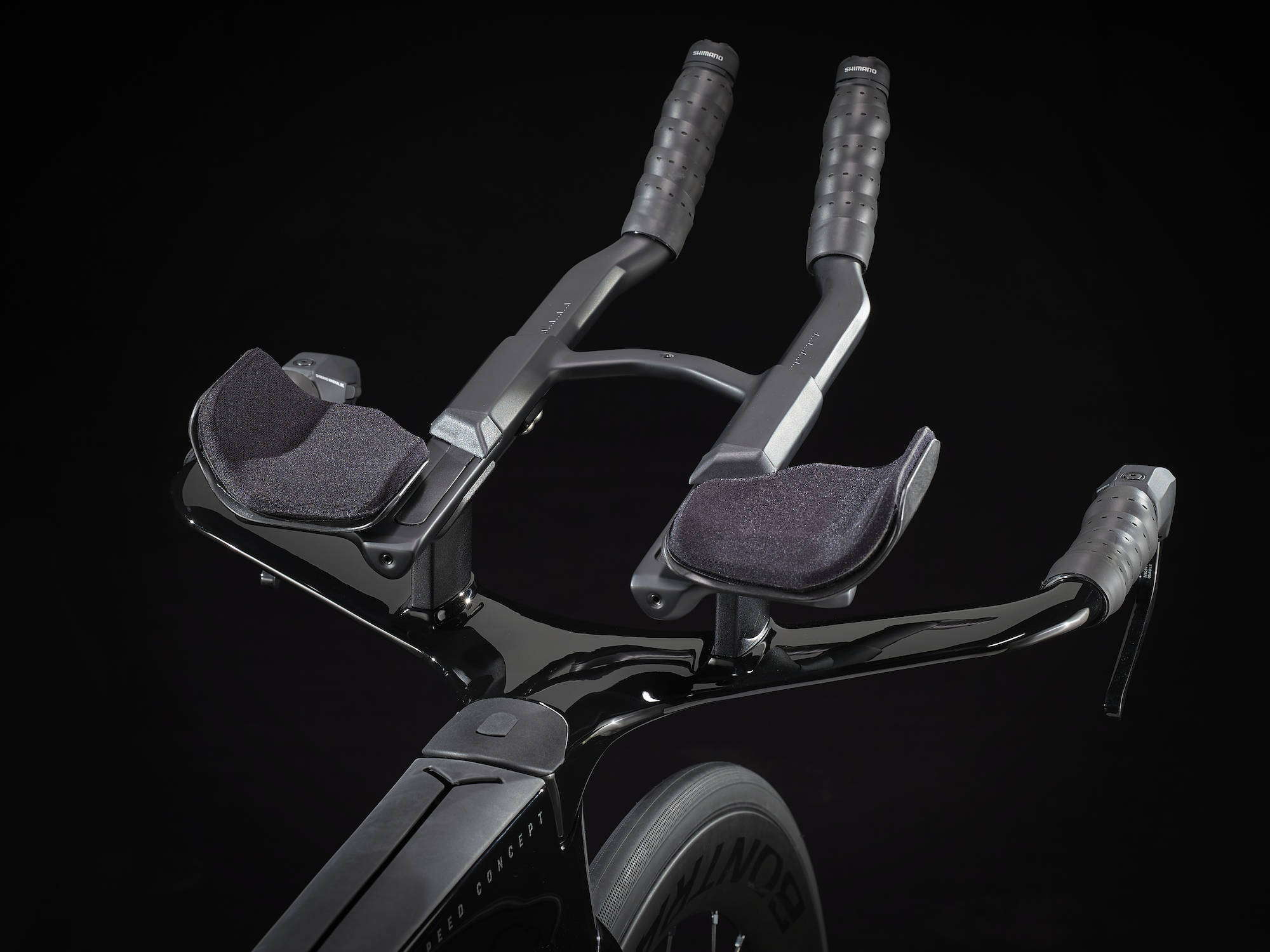
Beyond this, you can also choose between three different spacers to alter the angle, including zero, seven and 14 degrees. Vitally, there’s no need to re-cable the bike when making these adjustments, as the spacers and attachments have slots that allow the cables to slide through without re-wiring.
Three different tower toppers then allow you to adjust the pad reach position, while the extension base allows for 60mm of adjustment. The result is a total 160mm of reach that is ‘infinitely adjustable’, says Trek.
The extensions themselves also have three different reach adjustments, while the pads can be altered anywhere up to 120mm, with 10 degrees of rotational adjustment, but they can’t be moved forward or backward.
The brand’s engineers seemingly also understand the frustration of having to retune the bike to your position after breaking it down to take it abroad. As such, the bar on the Speed Concept has been built to be removable, allowing you to take it off and hang it beside the bike, ensuring your perfect position is preserved for race day.
Up to 40% more comfort
Fit is of course vital to comfort, but in addition to that, Trek has included IsoSpeed into the top tube. IsoSpeed has been utilised across the brand’s range for years, but this is the first time it appears in a triathlon bike.
Trek says IsoSpeed decouples the seat tube from the top tube, in an effort to allow the seat tube to flex with the forces of the road.
Compared to standard IsoSpeed positioning, Trek has moved the pivot further forward to match the forward weight bias of triathletes. This, along with an elastomer included under the pivot, delivers a claimed 30-40% more compliance when compared to the existing Speed Concept.
Not only does Trek believe this will help dampen rough roads, but the team also thinks this will help fight fatigue for a faster bike and run.
Trek Speed Concept models and pricing
Speed Concept SLR 9 eTap
- Price: £12,100
- Groupset: SRAM Red eTap AXS, with SRAM Red AXS power meter
- Wheelset: Bontrager Aeolus RSL 51
- Brakes: SRAM Red eTap AXS hydraulic disc
Speed Concept SLR 9
- Price: £12,100
- Groupset: Shimano Dura-Ace Di2 R9200
- Brakes: Shimano Dura-Ace Di2 R9200
- Wheelset: Bontrager Aeolus RSL 51
Speed Concept SLR 7 eTap
- Price: £9,250
- Groupset: SRAM Force eTap AXS, with SRAM Force AXS power meter
- Brakes: SRAM Force eTap AXS hydraulic disc
- Wheelset: Bontrager Aeolus Pro 51
Speed Concept SLR 7
- Price: £8,850
- Groupset: Shimano Ultegra Di2 R8150
- Brakes: Shimano Ultegra Di2 R8150
- Wheelset: Bontrager Aeolus Pro 51
Speed Concept SLR 6 eTap
- Price: £8,100
- Groupset: SRAM Rival eTap AXS, with SRAM Rival AXS power meter
- Brakes: SRAM Rival eTap AXS
- Wheelset: Bontrager Aeolus Pro 51


